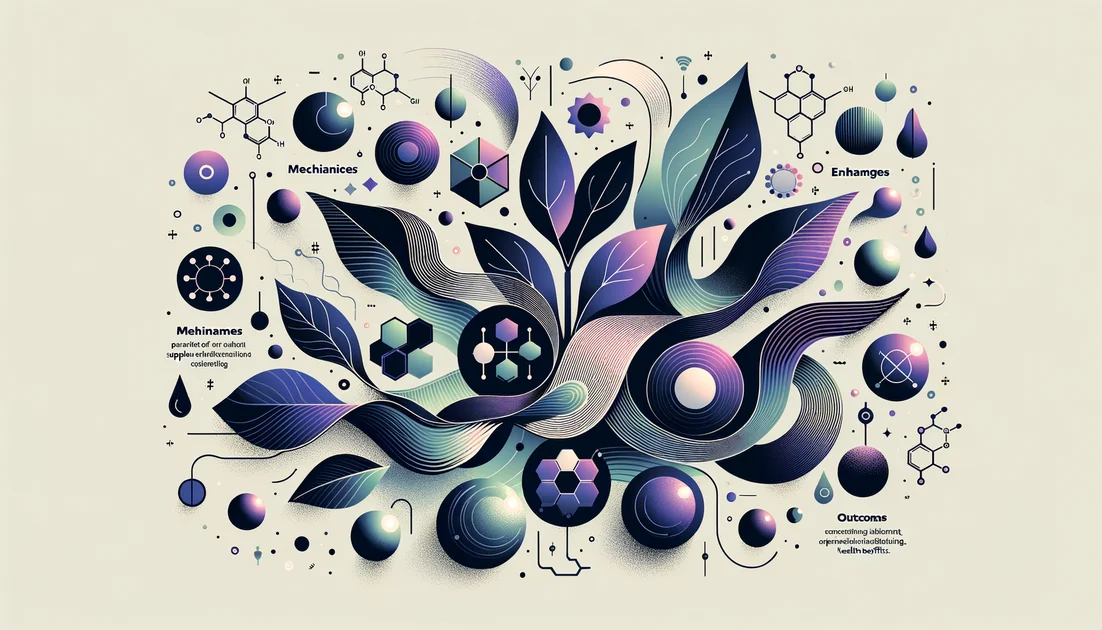
Liquid Jade, Modern Heart: How Green Tea Balances Calm and Cardiometabolic Health
Tea began as medicine, wrote Okakura Kakuzō in 1906; only later did it become a beverage. Today, a cup that once kept monks awake in meditation is being tested in clinics for quieter blood pressure, steadier lipids, and even a calmer gut wall—all without losing the paradox that makes green tea beloved: it wakes you up and settles you down at the same time. [2][1]
- Evidence
- Promising
- Immediate Effect
- Within hours (alert, calm focus from caffeine + L-theanine in a single dose) → 8–12 weeks for LDL and blood-pressure changes
- Wears Off
- 2–4 weeks after stopping, benefits diminish
The cup that quietly wakes you
On a tatami mat centuries ago, Zen monks whisked powdered green tea to stay alert through long meditations. Caffeine helped them keep their eyes open; the ritual helped them keep their minds still. That blend of vigilance and poise remains the drink's signature. Modern trials explain why: tea brings caffeine together with L-theanine, an amino acid that softens the edges of stimulation. In a randomized study, a single dose of L-theanine plus caffeine sharpened attention within an hour and reduced tiredness—think laser focus without the jitters. [1][3]
"Tea began as a medicine and grew into a beverage." — Okakura Kakuzō, The Book of Tea (1906). [2]
From poetry to prevention
Tea's journey from Chan monasteries to daily life is well chronicled—the Japanese tea ceremony, shaped by Zen, made reverence for simplicity part of the brew. [1] Today, epidemiologists follow a quieter ceremony: repeated cups over years. In Japan's Ohsaki cohort, people who drank five or more cups daily had lower risks of death from all causes and from cardiovascular disease compared with those drinking less than a cup—a signal strongest in women. Observational studies can't prove cause, but they can point us toward what to test. [7]
What controlled trials actually show
When researchers pooled dozens of randomized trials, green tea produced small but reliable improvements in heart-risk markers: LDL cholesterol dropped by roughly 4–5 mg/dL on average; total cholesterol fell too. Triglycerides and HDL barely moved. That's not headline material—but across millions of cups, small changes matter. [4] Blood pressure tells a similar story. Meta-analyses of randomized trials show modest reductions—about 1–2 mmHg on average—with clearer effects when people keep drinking tea for 12 weeks or more. It's the slow work of habits, not a quick fix. [5][6]
Your microbiome on tea
A newer plot twist is happening in the gut. In a 2024 double-blind crossover trial, adults with metabolic syndrome and healthy controls consumed a decaffeinated green tea extract confection (catechins equal to ~five cups of tea) for four weeks. Fasting glucose fell; markers of gut inflammation (calprotectin, myeloperoxidase) declined; and a urine test showed tighter small-intestinal "seams," suggesting less leakiness. Systemic inflammatory markers didn't budge, but the gut barrier looked sturdier. [8] As study author Richard Bruno put it, within one month we're able to lower blood glucose in both people with metabolic syndrome and healthy people, and the lowering appears related to decreasing 'leaky gut'. It's an early, compelling clue that some of green tea's metabolic effects may begin in the intestinal wall. [9]
Teeth, iron, and other paradoxes
Tea's reputation sneaks into the dentist's office, too. Small randomized trials of green-tea rinses trimmed down Streptococcus mutans—the cavity-forming bacterium—and eased gingival indices, performing comparably to chlorhexidine in short-term measures (with better taste and no staining). Your morning cup isn't a mouthwash, but the same catechins that color your brew also hassle plaque-makers. [11][10] Yet those catechins come with trade-offs. They bind non-heme iron, the kind in plants, and can curb its absorption when tea is taken with meals. In controlled feeding studies, iron uptake dropped when green tea extracts accompanied food. If you're prone to iron deficiency, drink tea between meals or add vitamin C-rich foods to counter the effect. [16] Green tea also concentrates differently depending on form: brewed leaves preserve more catechins than black tea, and powdered matcha is more concentrated still—higher in both polyphenols and caffeine. As Harvard's Frank Hu notes, two to four daily cups of green or black tea fit comfortably into a healthy pattern. [17]
"Several recent analyses have found that higher consumption of tea..is associated with reduced risks of heart disease, high blood pressure, stroke, diabetes, and early death." — Frank Hu, Harvard T.H. Chan School of Public Health. [17] Nutrition experts also remind us of limits: green tea doesn't meaningfully drive weight loss on its own, and its best role is as a pleasant swap for sugary drinks. [18]
When a good leaf goes wrong: extracts and the liver
A few pages of the green-tea story read like cautionary tales. Brewed tea has a strong safety record. But high-dose extracts—especially supplements delivering around or above 800 mg of EGCG per day—have been linked to liver-enzyme elevations in trials, prompting Europe's food-safety authority to flag doses at or above that level as concerning. [12] Real people sit behind those statistics. A 37-year-old woman developed jaundice four months after starting a weight-loss product rich in green tea extract; when she unknowingly retried the product a year later, the hepatitis returned—classic proof of causality. She recovered after stopping. [14] In the U.S. Drug-Induced Liver Injury Network, six women using a green-tea-containing weight-loss brand developed severe hepatitis; one required a liver transplant. These are rare events set against millions of users—but they are real. [15] The U.S. National Center for Complementary and Integrative Health adds practical safeguards: brewed tea is generally safe; some extracts can cause GI upset or raise blood pressure; and green tea can interact with drugs like nadolol, atorvastatin, and raloxifene. Genetics may matter, too—certain HLA types appear to raise susceptibility to extract-related injury. [13][14]
How to drink for benefit
Think in cups, not capsules. Two to four cups daily is a sensible target; lipid and blood-pressure effects tend to show after 8–12 weeks. [4][5][6][17]
Time it. For iron concerns, sip between meals or with vitamin-C-rich foods; for the calm-alert effect, mid-morning works for many. [16][3]
Choose quality and preparation. Brew freshly heated (not boiling) water over leaves for 2–3 minutes; matcha packs a stronger caffeine/catechin punch. [17][18]
Be careful with extracts. If you use them at all, avoid high doses; stop and seek care for fatigue, dark urine, jaundice, or abdominal pain. Check for drug interactions. [12][13]
Where the story is heading
Future chapters will likely focus on the gut–tea axis—which microbes flourish with regular catechins, who benefits most, and how genetics and medications influence safety. The emerging picture is not a miracle cure but a ritual with measurable edges: a daily practice that nudges risk factors, steadies attention, and, for many, replaces something worse. In other words, the old paradox holds. Green tea can be both a pause and a push—liquid jade that turns down the noise just enough for the signal to come through. [2]
Key takeaways
- •Calm alertness: caffeine plus L-theanine sharpens attention within an hour while softening jitters.
- •Cardio effects: randomized trials show small reductions in LDL (
4–5 mg/dL) and blood pressure (1–2 mmHg). - •Habit matters: higher intake (about ≥5 cups/day) links with lower cardiovascular and all-cause mortality in large cohorts.
- •Practical dose: most adults do well with 2–4 cups (8-oz) daily; changes typically appear after 8–12 weeks.
- •Timing tips: drink mid-morning or early afternoon; take between meals if iron is a concern.
- •Safety first: avoid high-dose extracts (≥800 mg EGCG/day) and monitor for liver-related symptoms; check drug interactions (e.g., nadolol, atorvastatin, raloxifene).
You might also like
Explore more of our evidence-led investigations, comparisons, and guides across every article style.

Thorne
The Paradox: Sports-trusted testing, guarded transparency—and a recent certification misstep

Fish Oil (EPA+DHA from fish oil) vs Krill Oil (Antarctic krill oil)
For most people seeking proven heart benefits or triglyceride lowering, choose fish oil (or prescription EPA) because outcomes data are strongest. Pick krill oil if you prefer smaller caps and potentially gentler GI feel, knowing EPA+DHA per capsule is usually lower. [4][6][1]


Nicotinamide Mononucleotide (NMN)
Consider a paradox: a vitamin cousin once used to cure a deadly deficiency disease is now the centerpiece of a 21st-century debate about slowing aging. The molecule is NMN, an immediate building block for NAD+—the cell's "charge card" for making and repairing life's energy deals. Can topping it up actually help you feel and function younger?


Tocotrienols
The stealthier cousins of vitamin E—built with springy tails that move differently in cell membranes and behave differently in your body.
